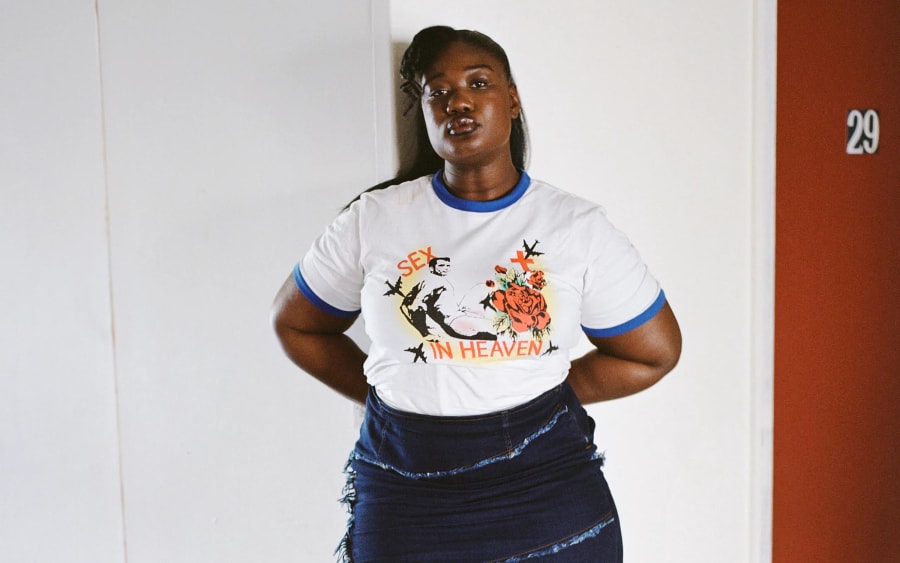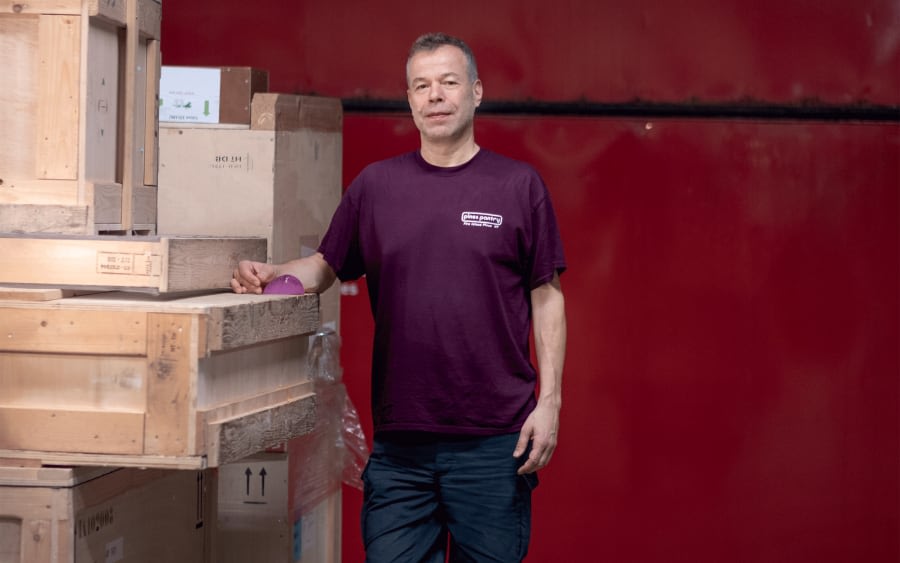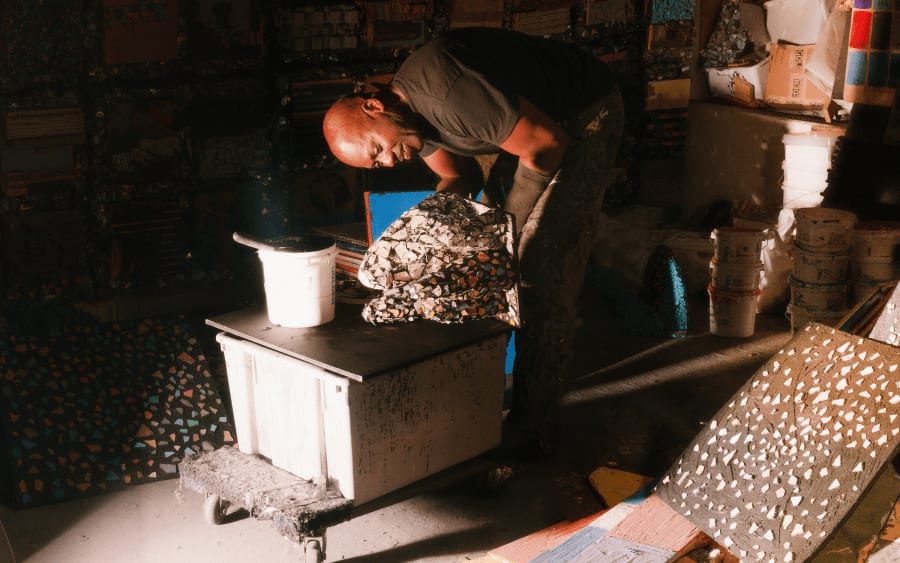Located in the Saadiyat Island cultural district, teamLab Phenomena Abu Dhabi rubs shoulders with the silver-domed Louvre and the near-complete Guggenheim, a pile of geometric toy blocks designed by Frank Gehry. It is run in partnership with the Department of Culture and Tourism, Abu Dhabi and the Miral Group, the same company that operates the Warner Bros., Ferrari, and SeaWorld attractions on Yas Island, a 20-minute drive away. In some respects, teamLab Phenomena would have been equally at home among them. It is as amusing as any amusement park. Since opening in April, thousands of people have visited.
Designed in collaboration with Abu Dhabi firm MZ Architects, the teamLab Phenomena building is all curves. From above it resembles a skate park, though it is closer in size to a basketball stadium. At 17,000 m², Phenomena is teamLab’s biggest site yet, dwarfing their next biggest locations in Tokyo and Jeddah.
Inside are 26 different artworks, including a towering projection-mapped forest, a mesmerizing laser hologram ceiling, and a waterfall, fizzing and frothing, lit by colored lights. Some installations will be familiar to visitors to other teamLab locations, but the best of them are new.
When we meet at the museum’s top floor café to discuss the collective’s latest creations, teamLab cofounder Toshiyuki Inoko fires off a string of English-language thank yous, like a rock star arriving on stage. He is dressed like a rock star too, in pale blue jeans, a thoroughly distressed jean jacket, and a pristine white T-shirt that looks like it was made on a loopwheel, the retro, expensive way.
Though he would never describe himself as the front man, Inoko is the creative impetus behind teamLab, which he founded in 2001 with Daisuke Sakai, Tetsuya Tamura, Joe Yoshimura, and Shunsuke Aoki. Today, teamLab has around 1,000 members, some of whom make art and some of whom work on digital solutions.
Inoko believes that management kills creativity: ‘We manage the company by not managing it,’ Sakai told Harvard Business School researchers in 2017. Instead, ‘catalysts’ recruit other staff to collaborate on projects they want to work on. Performance is determined by colleagues’ assessments of how yabai (insanely awesome) they are.
Creating the right conditions for something yabai to emerge is also how the art itself operates at teamLab Phenomena Abu Dhabi. The first work you encounter is displayed on a plinth in the center of a small, dark antechamber. Iridescent colors illuminate a shimmering pebbled surface that suggests the skin of some exotic python. The colors tremble as they travel across the black surface, which, when you touch it, is nothing more than water.
This work, Living Crystalized Light (2022), is an example of what teamLab calls a ‘cognitive sculpture’ – something that owes more to our perception and imagination than any lasting physical properties. A beautiful object is conjured into being – by shining colored light onto ripples fixed by carefully calibrated vibrations, at a guess; teamLab does not disclose their secrets – and then disappears.
There are three major works that build on this idea of sculpture without substance. Morphing Continuum (2025) is a room with mirrored walls and wind currents that, along with other elements that teamLab keeps secret, help shape thousands of silver balloons into tall twisters that dissipate and reform as you move between them. In Levitation Void (2025), a roughly 9-meter-tall black sphere – painted so matte that it appears more like a flat circle – floats freely in a red-lit room, inscrutable as an alien intelligence, drifting slightly up and down, left and right, before regaining equilibrium.
Most staggering of all is Massless Amorphous Sculpture (2020), a world of purple-tinted storm clouds that build, surround, and at times envelop visitors. (The work was first shown at teamLab SuperNature Macao on a smaller scale.) On my own visit, I was totally enchanted, lost, becoming one with the cloud until, eventually, I felt the sting of detergent in my eyes. Plastic goggles and hooded white overalls are provided for protection, but I foolishly had the goggles up and the hood down, leaving my head slick with soap.
These three works – all of which are primarily made of air – were inspired by tidal whirlpools that form north of Inoko’s hometown, Tokushima. The Naruto whirlpools are created by water that speeds through the Naruto Strait, generating vortices up to 20 meters in diameter. They have been observed for centuries; ukiyo-e artist Utagawa Hiroshige depicted them in No. 55. Rough Sea at Naruto in Awa (1855) from his ‘Famous Views of the 60-Odd Provinces’ series.
‘You see [a whirlpool] as something that exists but you can’t separate it from its surroundings,’ Inoko says. ‘You can’t separate it from the ocean, and it can’t exist in a box.’
Similarly, Morphing Continuum, Levitation Void and Massless Amorphous Sculpture cannot exist outside their environments because they are their environments. They are air in the air, just as the Naruto whirlpools are ocean in ocean. (The considerable queue that forms to enter the detergent clouds is another sculptural phenomenon, an eddy in the flow of visitors through the building, but it is not one that teamLab draws attention to.)
‘What people have created historically just happened to be tangible objects, so that’s how people perceive the world, but there’s actually a lot of the world that is not object-based in the physical sense,’ Inoko explains. ‘Wouldn’t it be great if people’s perceptions of this world could expand further than that?’
Inoko says teamLab’s preoccupation with massless sculptures builds on the offering at teamLab Borderless in Tokyo, where works are inseparable from their environment – responding to one another and to viewers. It could also be traced back further, to facile criticisms that their early work, powered by software, is not art because it is not something you can hold.
It is not just teamLab’s artwork that contests simplifications. The Abu Dhabi venue is both an art gallery and an attraction. They are an art collective, a creative company, and an ‘ultra-technologist group,’ – a term they used to describe themselves back in 2017. As teamLab continues to grow, sharing with the world its mochi-soft power message that we are all part of the same phenomena, I ask Inoko how his own role has changed.
‘With more members and these larger-scale projects, I find that I can now put almost a hundred percent of myself towards making, in comparison to when we were just a few people. In general, I don’t think the process has changed that much. I come up with the concept, think about what I want to make, and then enter this kind of eternal, detailed process of realizing that with the team.’
While he is not especially interested in micromanaging individuals, Inoko is deeply involved in the pivoting and problem solving that goes into making the works. In that way, he says, ‘it might be the ultimate micromanagement.’
While Inoko comes up with the concepts, he disavows the idea that he holds teamLab’s creative vision. ‘One person doesn’t really know what the entirety of a future is,’ he says.
Roughly 4 million people visited teamLab Planets and teamLab Borderless in Tokyo in 2024 – and that is just two of over 20 locations they operate worldwide. In 2023, teamLab Planets had 2.5 million visitors, easily eclipsing the next biggest museum dedicated to a single-artist or art collective, Amsterdam’s Van Gogh Museum, which saw 1.7 million visitors. Globally, it is easy to believe more people spend more time in the presence of teamLab artworks than those of any other artists, living or dead. Given teamLab’s seemingly limitless success, is Inoko ever tempted to foreground his own contribution the way other artists with massive studios – like Yayoi Kusama or Zhang Huan or Jeff Koons – do? To be the rock star he presents as?
‘Maybe it’s a cultural thing but I always felt like it was unnatural to put one name on what we do,’ he says. ‘In the beginning, like 20,000 people told me I should put the artworks out there under my name.’
That, though, would be conceptually out of step with teamLab’s philosophy, which asks the same thing the Buddhist asked the hotdog vendor in an old joke: ‘Make me one with everything.’ It would mean being, by some metrics, the biggest artist on the planet, a celebrity like Cate Blanchett or Brendan Fraser, or a figurehead like Sheikh Khaled bin Mohamed bin Zayed Al Nahyan, Crown Prince of Abu Dhabi – all of whom attended the opening of teamLab Phenomena Abu Dhabi. It would mean being the center of attention, the way Italian composer Ludovico Einaudi was when he played the piano for guests gathered outside at the opening, while ripples of blue light seemed to ascend the building’s exterior and 6,000 drones lifted the light show into the night sky.
‘I just want to make,’ Inoko says.
teamLab is represented by Pace Gallery (New York, Berlin, Geneva, Hong Kong, London, Los Angeles, Seoul, Tokyo), Martin Browne Contemporary (Sydney), and Ikkan Art (Tokyo).
Sam Gaskin has covered contemporary art for over a decade, mostly from Shanghai, China. He has reported on art scenes across the Asia-Pacific region for publications including Ocula, Artnet News, Artsy, and for news outlets including Financial Times, The Guardian, CNN, and Vice. Sam currently lives in Hobart, Australia.
Caption for header image: Toshiyuki Inoko. Photo by Shuji Goto.
Published on July 1, 2025.


